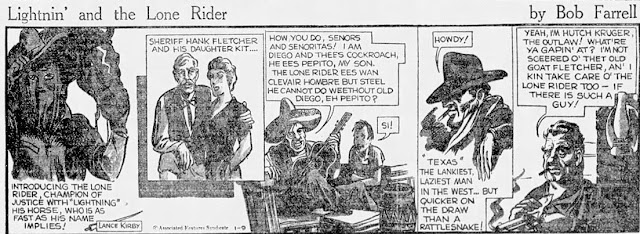The History of Comic Art - one artist, one horse, at a time!
When we last left Jack Kirby, around 1939, he was still working on comic strips for H. T. Elmo and his Lincoln Newspaper Features. However, in early 1938 Kirby also answered a newspaper ad placed by the newly formed Eisner and Iger Studio and was quickly assigned series by Eisner like an adaptation of The Count of Monte Cristo and the science fiction themed Diary of Dr. Hayward. The third series, Wilton of the West, was Kirby’s first western, and its publication in Fiction House’s
Jumbo Comics #1 (see below) in the Fall of 1938 provided us with Kirby’s first horse to appear in comic book form. Kirby signed the first Wilton story under the familiar pseudonym of Jack Curtiss, but beginning with Jumbo Comics #2 the four page Wilton series by Kirby was credited to a Fred Sande. By issue #4, Lou Fine was the new “Fred Sande” on Wilton and Kirby had moved on.
Note: Most, if not all, of the product from those Jumbo issues had originally been produced by I & E for Wags comic distributed in England and Australia. Kirby’s Count and Hayward both appeared in Wags first. GCD makes no such determination, however, for Wilton of the West. I’m making inquiries and will modify this post if this question gets answered.
Kirby only did 12 pages of art for the Wilton western, but it was enough to show
Associated Features Syndicate and its owner/writer Bob Farrell and be hired to do the art for Farrell’s new daily newspaper strip, Lightnin’ and the Lone Rider. By November of 1938, newspapers were promoting the strip’s arrival in early January 1939. Kirby, using the alias Lance Kirby, only worked on the strip for six weeks before Farrell apparently replaced him with another new face, Frank Robbins. Robbins lasted nine weeks before the strip was cancelled. The image below and much of the information immediately above came from the incredibly resource - Stripper’s Guide. In horse news, I’d add that the Lone Rider’s horse, Lightnin’ actual receives top billing, which may be a first.
Those six weeks of Kirby pages were cut and pasted into comic book narrative form and ran in Famous Funnies #61 - 66 (August 1939 - January 1940). The story actually began with issue #62, but this promotional piece ran in the preceding issue. There’s only two Kirby rows in issue #66, before the shift to Robbins.
Next: Simon and Kirby




No comments:
Post a Comment